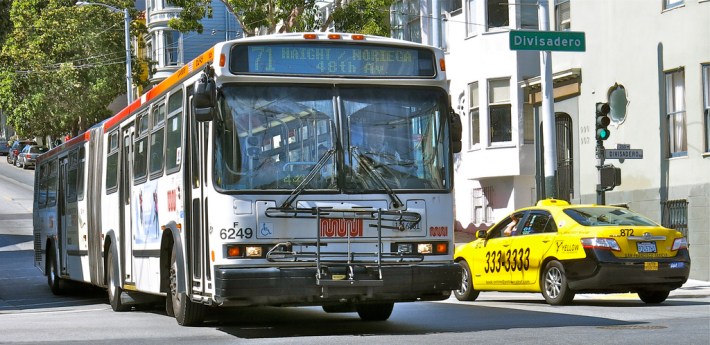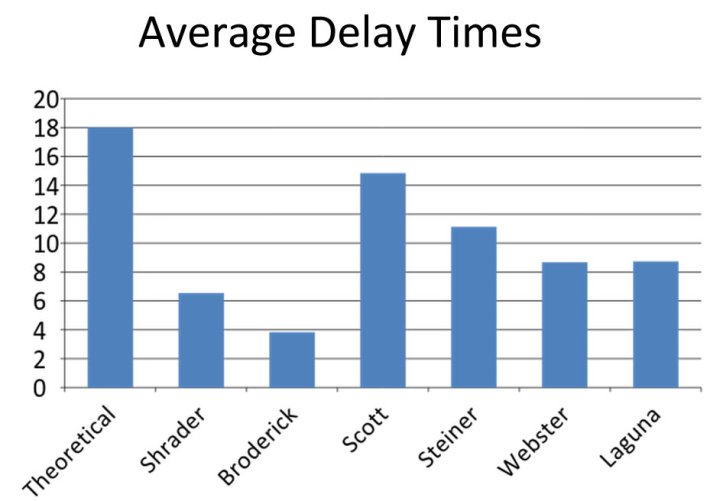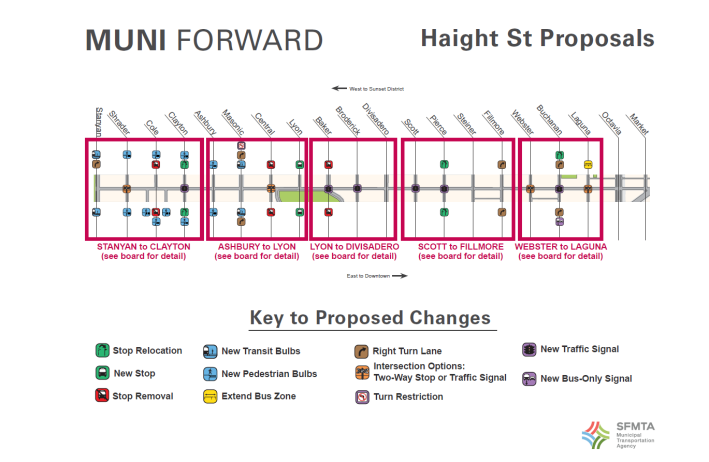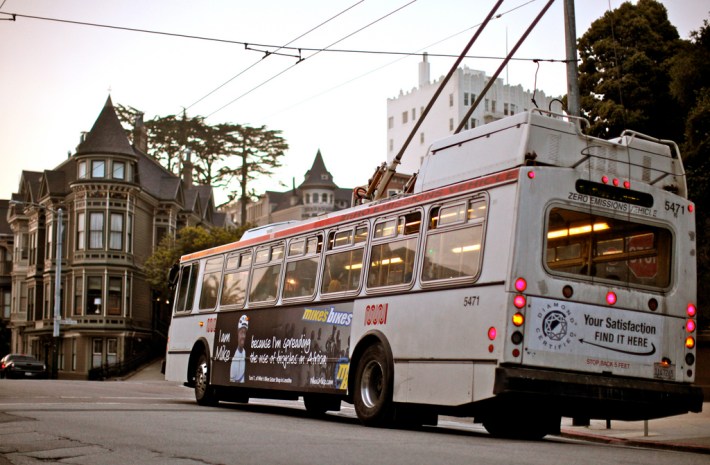
On Tuesday, the SFMTA Board of Directors approved plans to add traffic signals and bulb-outs along Haight Street, which could speed up Muni's 6 and 71 lines and improve pedestrian safety. The approval came despite complaints from some Upper Haight merchants over removing parking for bus bulb-outs, and mixed support for new traffic signals from pedestrian safety and transit advocates.
Under Muni Forward's "Rapid" plans for the 71, almost all stop signs along Haight will be replaced with either transit-priority traffic signals, or two-way stops combined with traffic calming treatments. The signals, which stay green when they detect buses, would be installed at Clayton, Baker, Broderick, Scott, Pierce, and Buchanan Streets. Either a two-way stop or a new signal would be possible at Shrader, Central, Webster, and Laguna Streets.
Muni has similar plans for Muni's 5-Fulton and for other routes under Muni Forward, which previously was called the Transit Effectiveness Project. SFMTA planners say Muni riders stand to save a lot of time thanks to the new signals, combined with a relocation of bus stops from the near side to the far side of intersections. The SFMTA claims it takes an average of 18 seconds to clear a stop sign, counting deceleration, queuing behind cars, and acceleration.
But the speed benefits of signalization are contested by Michael Smith, the former Chief Technology Officer and General Manager of NextBus, who co-founded Walk SF. SFMTA staff have not responded to his challenge to their estimates -- neither to a request from Streetsblog, nor at the board hearing -- but street safety advocates say that they might not justify costly signals, which restrict movement for people walking and biking (in this case, on the Wiggle). "MTA hasn't convinced neighbors and pedestrian advocates of that," said Livable City Executive Director Tom Radulovich.
"All of these proposals are great, but traffic signals are questionable," Smith told the SFMTA Board. He presented data [PDF] he said he collected by riding the 71 with a timer "for several hours," showing that delay times at stop sign intersections on Haight aren't close to the 18-second estimate.
Based on his analysis, Smith concluded that most of the proposed signals would only save a few seconds, if any, and that the busy Scott Street intersection is the only spot that justifies a signal.


"Signals will still cause some delay," said Smith. "Not every bus gets a green light, even with transit-preferential signaling."
As for signals' effect on injuries and speed, an SFMTA flyer [PDF] says that after a study of 12 intersections that were signalized, “We found that the total traffic related pedestrian collisions at these intersections decreased from 30 to 8, indicating a safer pedestrian environment."
But Walk SF Executive Director Nicole Schneider told the SFMTA Board she "comes at this with some mixed thoughts. " Planners in Sweden, the birthplace of Vision Zero, say they avoid adding signals in favor of treatments like roundabouts, which maintain slower speeds and "forgive" mistakes by street users and minimize the risk of crashes. Traffic signals, meanwhile, give motor vehicle drivers carte blanche to coast through an intersection.
"If someone jaywalks, with a signal that might mean their life -- whereas a stop sign, or things like roundabouts, might be safer," said Schneider. "It sounds like we might need to take a better look at certain intersections and determine if a traffic signal is the best solution."
Still, the plans were heartily supported by speakers from the SF Transit Riders Union at the hearing. Jarrett Walker, a transit consultant based in Portland and former SF resident, wrote on his blog that the SFMTA's approach seems sound, though he declined to comment on the more technical questions about estimated stop sign delays.
Peter Straus, an SFTRU member and retired Muni service planner, told the SFMTA Board that he lives a block away from Haight and Pierce Streets, one of the intersections set to get traffic signals. "I don't think they're things that people should be afraid of, if they're properly managed" by synchronizing signals for slower speeds, he said. The SFMTA says it plans to do so.
"It's incumbent on us," said Straus, "to move ahead and show results quickly" after voters approved funding for Muni improvements with Propositions A and B, and rejected the cars-first Proposition L, in the November 4 election. "I'm glad to see [these plans are] on a relatively short time frame," he said. The project is set to be constructed late next year.
Aside from the signals, several merchants at the hearing protested the SFMTA's plans to remove parking and loading zones to create sidewalk extensions at bus stops and crosswalks. A few, including the owners of Amoeba Music, also said they thought transit bulb-outs would cause car traffic to back up, since buses would stop in the traffic lanes to load passengers.

Christin Evans, owner of Booksmith and a board member of the Haight-Ashbury Merchants Association, said the organization "unequivocally" opposes the addition of transit shelters and seating. HAMA and SFPD Park Station Raj Vaswani both think the shelters will be attractive places for people to drink and deal drugs, according to a letter from Vaswani read to the SFMTA Board by Supervisor London Breed's aide, Conor Johnston.
But Muni Forward Program Manager Sean Kennedy said that shelters, seating, and loading zone changes were not among the items up for approval by the board. Only roadway changes, like bulb-outs, traffic signals, left-turn bans, and two stop removals, were under consideration. Altogether, Muni predicts the improvements will save three of the 11 minutes -- 25 percent -- of the average time it takes the 71 to travel between Laguna and Stanyan Streets.
"This is how we think we're going to get to a more reliable transit system," said Kennedy.
Breed doesn't have a specific position on the proposals, said Johnston, but she is concerned that shelters and signals could affect public safety.
Evans said that the Muni Forward plans for Haight "are in conflict" with the Haight-Ashbury Public Realm Plan, a community planning effort that the Planning Department is undertaking, with a focus on streetscape improvements. City planners have said the two plans will work in tandem, and that the Muni improvements up for approval were vetted by the public through the Public Realm Plan.
In April, Evans told Streetsblog that HAMA may be split over parking removal, but might be open "to make the trade off, if the planners design compelling streetscapes which accommodate improved flow to/from the neighborhood."
Last week, though, HAMA's letter to the SFMTA Board read, "The SFMTA joined the process late, and always appeared to have a clear agenda of driving through transit-first initiatives, such as bulb-outs, stop lights, and the addition of transit bulbs with bus shelters... there's been very strong opposition to seating and bus shelters in particular."

The plans would complement the contra-flow Muni-only lane that opened on the Haight's two easternmost blocks last month, providing eastbound buses with a more direct route to Market Street. The center-running transit lane bypasses a queue of freeway-bound drivers from Laguna to Octavia Boulevard, and will be extended one block west to Buchanan.
The only SFMTA directors who voted against approving the changes were Jerry Lee and Gwyneth Borden, the board's newest member. Borden said more time was needed to work out the issues, and that she "had a hard time with" the appearance that those voicing concerns weren't being taken seriously. "I don't think you can overlook when there are so many diverse groups of people, with varying problems, in a particular area," she said.
Radulovich of Livable City said the plans for bulb-outs don't go far enough. "They don't round the corner, as called for in the city's" Better Streets Plan, and bulb-outs are "missing from some important intersections," he said. "Haight Street was SFMTA's first opportunity to make a TEP project into a complete streets project, and they fell short. We hope they'll keep at it until they get it right."




